Category: Hunting Blog
5 Reasons You Should Film Your Hunt
If a picture is worth 1,000 words, what is a video worth? For many hardcore hunters, the videos of their hunts are priceless yet many hunters still don’t film their hunts. There are a wide variety of reasons people don’t want to film their hunt. Some are afraid of the amount of work filming a hunt can be. Others don’t want to invest in the proper equipment. Some are afraid of learning how to use camera gear. If this sounds like you, now is the time to step outside your box and start filming. I recently interviewed Dr. Grant Woods from GrowingDeer about why every deer hunter should film their hunt. Below are five reasons Dr. Woods believes all hunters should pick up a camera and start filming.
SHARING THE STORY – RELIVING THE MEMORY
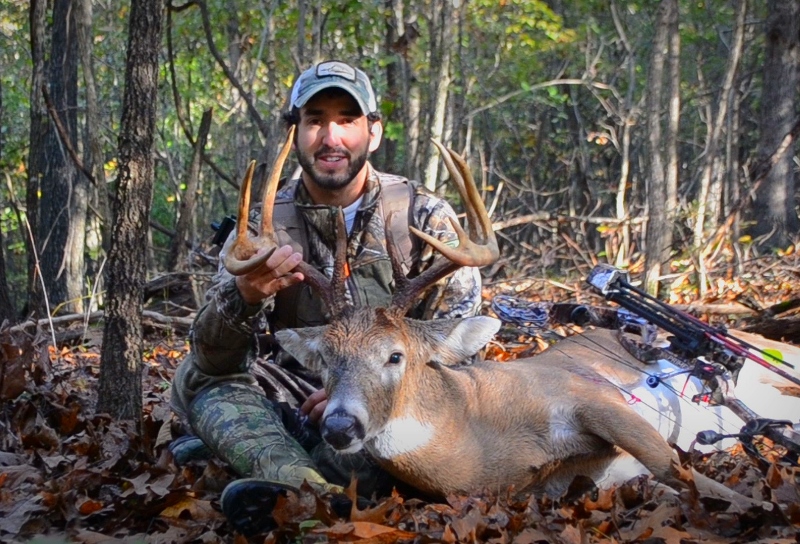
Whether you film the first buck you ever killed or film your child’s first successful hunt, there is something special about being able to watch the footage and relive the experience all over again. “We recently filmed my dad killing a buck on his 86th birthday. It was a special hunt because he turned 86 and he had just finished a long bout of chemotherapy. The first time he had hunted in a long time was his birthday and it was very special for my entire family. The fact that we will be able to go back and watch it repeatedly makes it more memorable. We were hunting in a bale blind and several turkeys showed up. Then a young buck came in and dad made a great shot on the buck with a crossbow. It was a great experience,” Woods explained. Over time, we often forget the details of special hunts like this. When you film a hunt, you can relive it repeatedly so you won’t forget any of the details.
EDUCATION – UNDERSTANDING DEER
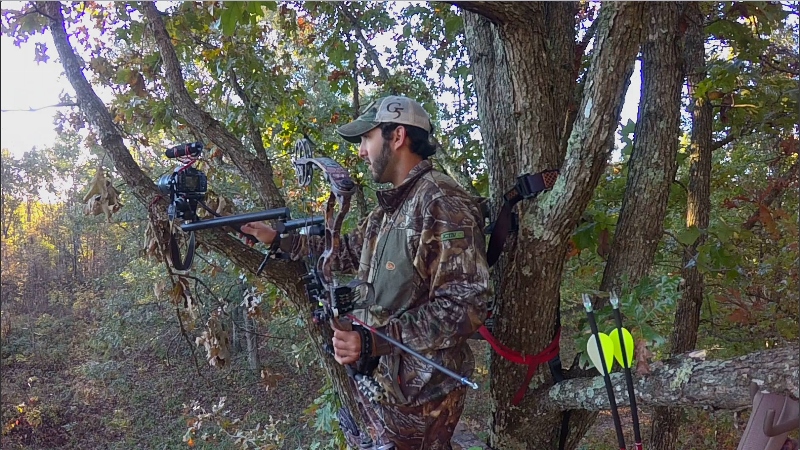
When you spend a lot of time behind the camera filming deer, sooner or later you are going to see and learn things about deer that you didn’t know before. For instance, Missouri is having a horrible drought this year. Woods sometimes wonders what types of food the deer like to eat when it is hot and dry. By filming deer feeding, Woods is able to determine what the deer like best. “We recently filmed deer feeding in one of our food plots and it was a food plot with a mix in it so there were a variety of things the deer could be eating,” Woods said. “But when we zoomed in, we noticed they were really going after the radishes. In fact, they are almost all gone. Anytime you can learn something like that, it might help you choose where you are going to hunt next time you go out.”
COMRADERY
Many hunters bring a cameraman into the woods with them when they are hunting. This can be a disadvantage because there is twice the movement and twice the human odor, but Woods believes the benefits outweigh the negatives. “When you have a friend with you filming, you can have fun chatting and discussing the hunt which helps pass the time,” Woods mentioned. “It also gives you an extra set of eyes and ears. We all use our smart phones when we are hunting which is a huge distraction. When I have a cameraman with me, we take turns watching for deer while the other person checks emails and looks at their phone.”
SHOT PLACEMENT & REVIEW
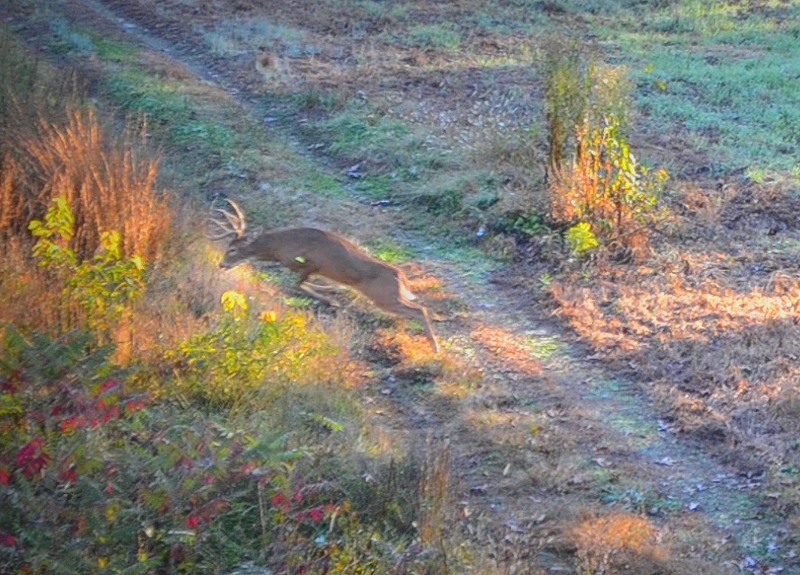
Probably one of the biggest benefits of filming a hunt is you can review shot placement after taking a shot. “The human eye can trick us,” Woods said. “Depending on the angle of the shot or what an arrow does in the air, the actual shot placement can differ greatly from where we think we hit a deer. Being able to go back and watch the shot after the fact allows us to determine if we want to go look for a deer right away or let it be for a little while or overnight. We have had many deer jump the string this year and being able to go back and see that our shot was made properly but the deer jumped is nice to have the ability to review so I am not so hard on myself thinking I made a huge mistake. All in all, being able to see where our shot placement was is a huge help when it is time to recover a deer.”
EVIDENCE OF THE ONE THAT GOT AWAY
Woods believes another great benefit to filming a hunt is proof that one got away and that you passed on a deer. Before people started filming hunts, if they passed on a young buck, all of their friends would say, ‘Yeah right.’ Now when a hunter passes on a buck, he can show his friends and talk about it and everyone will believe him. Not long ago, the same hunter probably would have shot the buck but having proof that he passed it up is as good as shooting it. Being able to film your encounters and show friends the buck that got away and the buck they passed on is huge. It is a great benefit of filming a hunt.
If after reading this you are convinced you should be filming your hunt, head over to Fourth Arrow Camera Arms. Check out their camera arms and their blog on getting started filming your hunt without breaking the bank.
About the Author: Tracy Breen is a full time outdoor writer, marketing consultant and motivational speaker. He works with a variety of companies including Fourth Arrow Camera Arms. Learn more about him at http://www.tracybreen.com.
Let the Chasing Begin!
Sweet November is here! For many deer hunters this means vacation time and long sits in a Summit stand. During the early portion of November bucks tend to be on their feet and searching for receptive does. Even though bucks are traveling, proper stand placement is key! Many stands hung at The Proving Grounds are ONLY hunted during this time of the year.
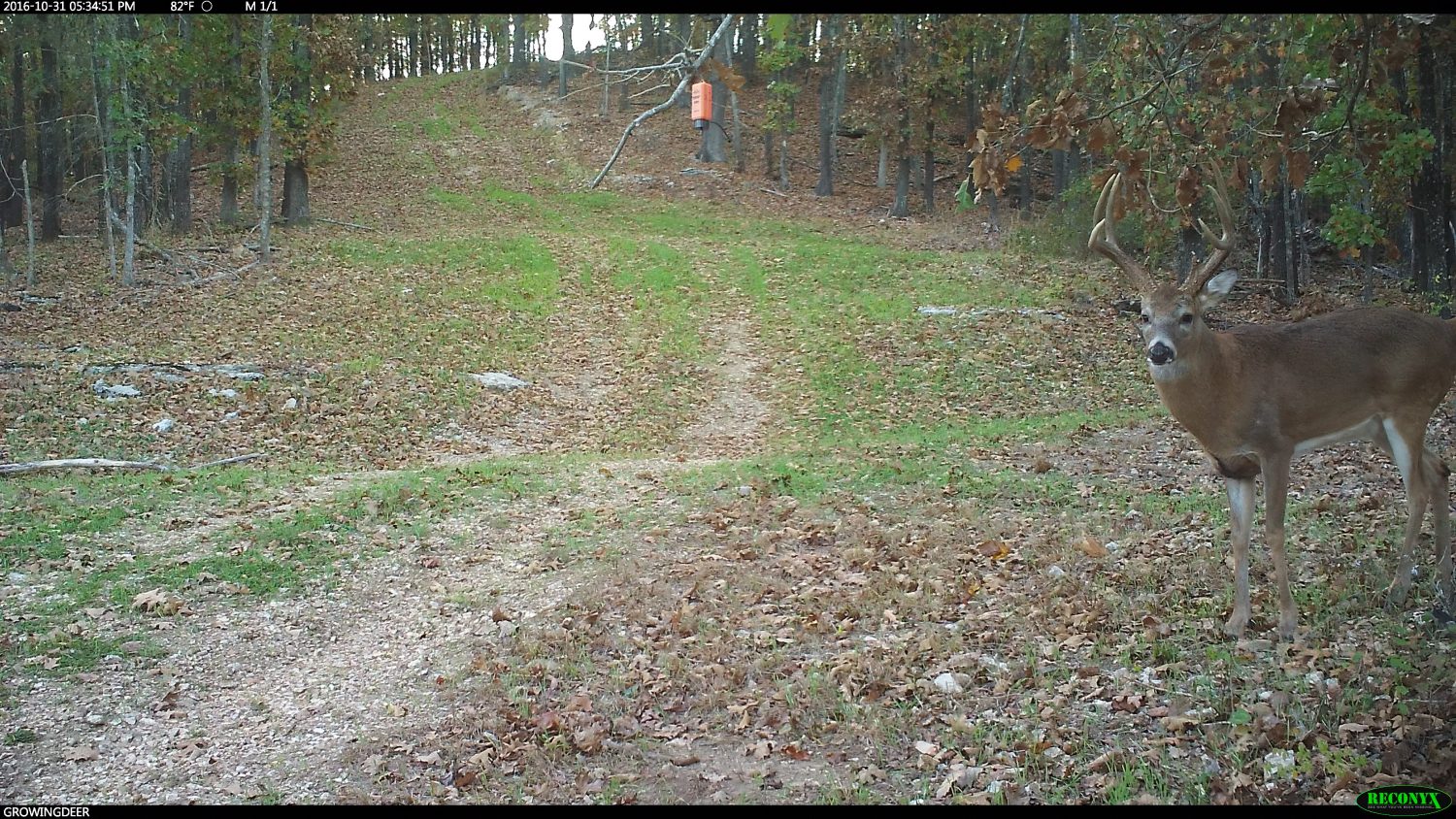
Southpaw is locked down on a doe. The chase phase is here!
When the pre-rut activity is hot, bucks put many miles on their feet. As a hunter it’s important to place yourself along heavily travelled corridors. It is common to hunt stands where does have been frequenting, like food plots or acorn flats. This can result in success, but this pattern can change quickly. Does will alter their patterns as a result of constant pestering from bucks. Since those patterns are subject to change, we focus on pinch points along travel corridors.
One of our favorite stands during this time of the year sits mid slope on a mountain we call 50 Acre. A ravine cuts up the slope from the creek bottom to a bench in the slope. The ravine and bench pinch nearly all the deer movement into a small 20 yard wide swath. Any deer traveling this half of the mountain is likely to walk past the stand within bow range. With bucks on their feet and nudging does these are the type of setups you will find us hunting. In different habitat types, similar areas may include converging creeks, fence rows, edges of bedding cover, or creek crossings.
Now is the time to get in the woods. Find travel corridors that concentrate deer and wait them out! You may just find a buck with his nose down and tail up heading your direction. Hunt hard and stay safe.
Enjoy Creation,
Matt Dye
Tough Hunting Conditions
It is hot out there! Across much of the whitetail’s range temperatures are warmer than average. This makes for less than ideal hunting conditions. Typically The Proving Grounds has already received a frost. To date, we’ve had one morning dip into the thirties. Needless to say, the hunting has been tough!
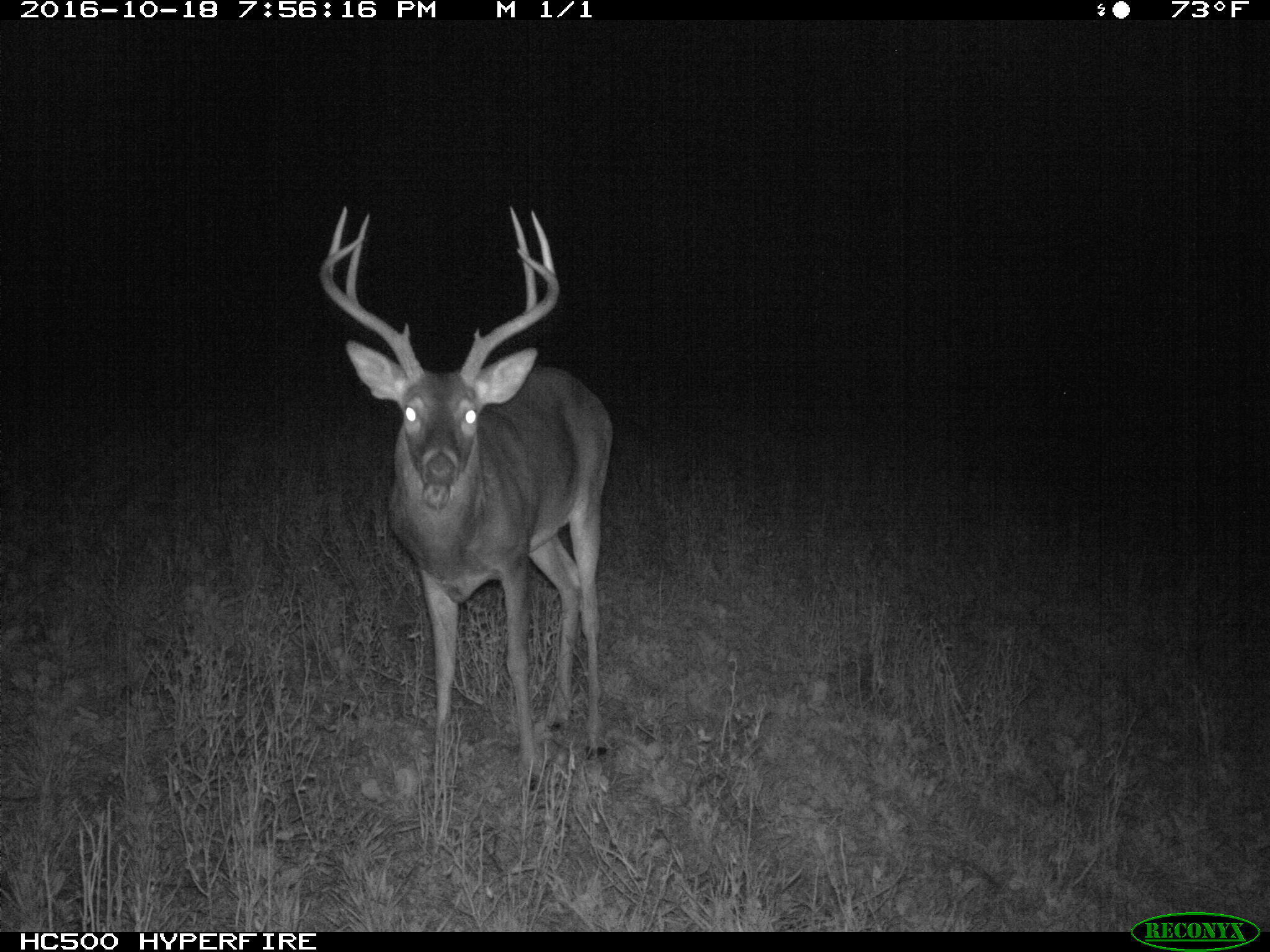
This buck is making regular appearances to this plot just after dusk!
Deer are not fans of moving when temperatures are unseasonably warm. They have already shed their summer coat; when conditions are warm deer movement tends to be slow during daylight. Here are a few techniques we use to fill the freezer when it is warm:
Hunt the Greens! We plant the Eagle Seed Broadside blend each fall. This is a four-way blend: soybeans, wheat, brassicas, and turnips. When planted appropriately, this food plot turns into a lush, thick stand of greens. The secret to greens is their attractiveness, as well as a food source with minimal carbohydrates. This means less energy or heat is built up. In return deer feed for longer periods and more often. When this occurs, deer tend to visit plots more often making the chances of tagging one even greater!
Hang Close to the Bedroom. By hanging stands close to bedding cover deer will travel a shorter distance before reaching your stand. The first and last half hour of daylight will be the best time to catch deer on their feet. Sliding in closer to the bedroom increases your chance of success. Entry and exit to these stand placements is critical! Don’t take short cuts, be thorough and success will follow.
The pre-rut is here, who knows what can happen! Get outdoors and embrace the warm weather by implementing these techniques!
Enjoy Creation,
Matt
Got Nighttime Deer Movement?
During this portion of the season many folks experience limited daylight deer movement. It can be frustrating to see hit listers on camera only during the cover of darkness. One of the most frequently asked questions is, “How do I hunt these deer?”
There isn’t a clear cut answer that will result in harvesting a nocturnal buck. Below are the techniques we use when hunting nocturnal bucks.
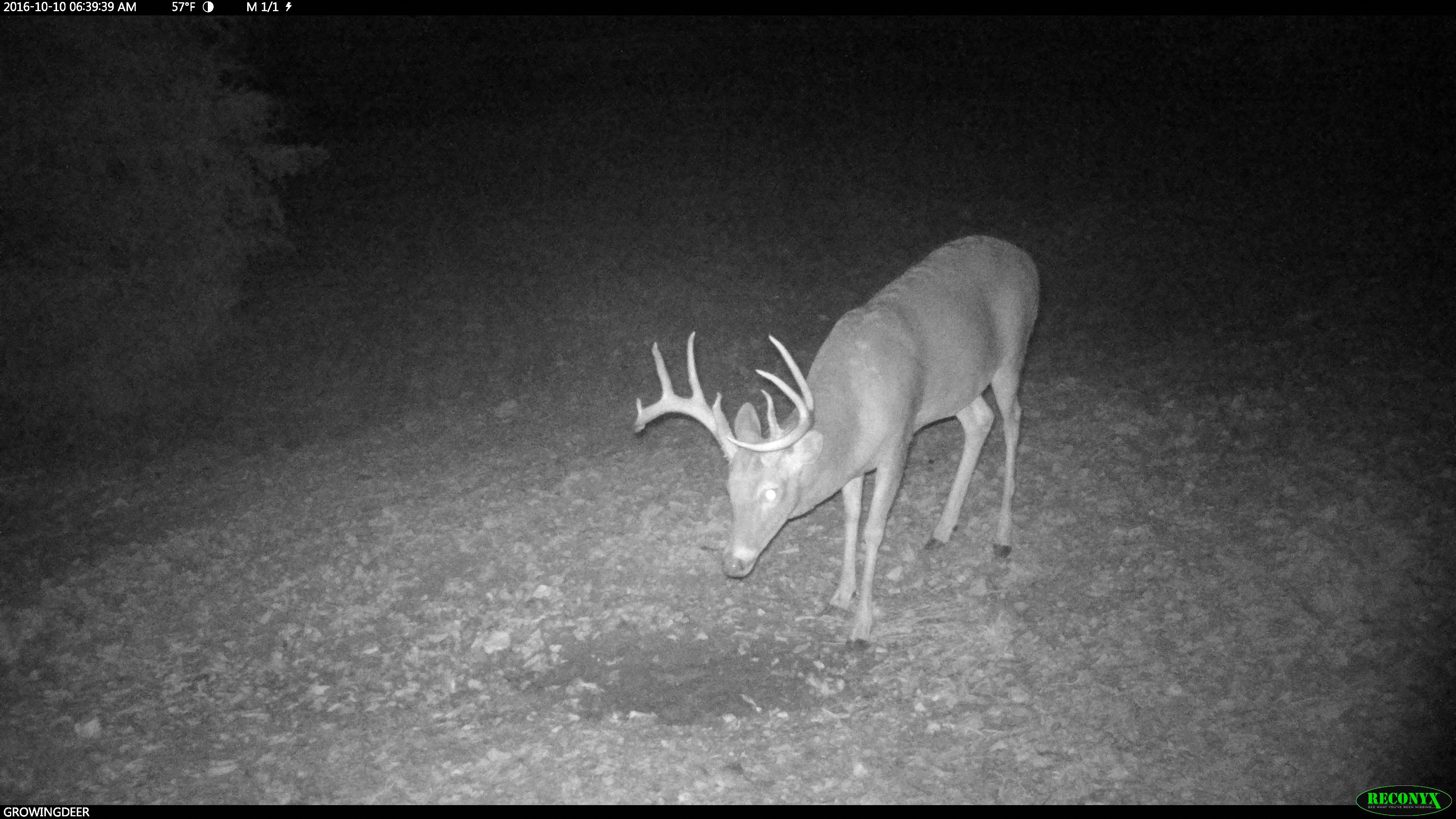
We are closing in on this 4.5 year old buck, Headturner. We may need to wait until the rut to hunt his preferred travel route.
One of the first things we do is cut the distance. We have designated sanctuaries at The Proving Grounds. Much of the bedding occurs within these areas throughout a season. When a mature buck has a nocturnal pattern we start to back track his movements. By using terrain features and known deer trails the preferred bedding areas can be located. Once we’ve pinpointed travel routes to and from the bedding area, we hang a Summit. By cutting the distance close to the bedding area the odds drastically increase.
Next, we sit and wait for the right weather. Cold fronts generally get deer up and moving earlier than usual. This is the time to slip into this stand and hunt, hopefully catching the nocturnal buck on his feet during daylight hours.
Another option, simply wait. If a buck is traveling through an area that is unapproachable then wait! Knowing when to hunt is often just as important as knowing when not to hunt. As the rut nears bucks will begin to travel more. Research out of Pennsylvania has shown bucks travel nearly three times as much during November as they do in October. With that being said, that same nocturnal buck will become more visible during daylight hours. To put the odds in your favor, it’s best to locate a heavily used pinch point in the area. Now you are in the best location to observe the increase in deer activity. Waiting until conditions are favorable is often the quickest way to success.
Remember, pressuring deer only makes them more nocturnal.
If trail cameras are lighting up after the sun has set, there is still hope! Depending on the buck’s core area and travel routes these hunting strategies can keep you in the game. Don’t give up on a nocturnal buck, there is a time and place when that deer will become harvestable.
Chasing Whitetails,
Matt
The Power Of Doe Patterns
Hold on to your seats, the rut is on the way! Within the next few weeks across much of the whitetails’ range pre-rut activity will increase. This spike in deer activity can make for excellent hunting. To capitalize on bucks spending more time on their feet during daylight hours, you need to find the does!
At this stage of the game, most hunters have bucks on their minds. But, if you plan on filling tags during the pre-rut phase, it’s important to know where the does are. During this stage bucks are just beginning to search and pester does. As a result, does have not yet begun to alter feeding or bedding patterns. This means they are still on a routine. It’s important to study patterns that show up on trail cameras and adjust stands to accommodate them. If done correctly stands will be ready when bucks are most active.
Don’t think you are the only one picking up on these patterns though. Scrapes are a line of communication among deer. By using scrapes deer can determine which individuals are most active in certain areas. Bucks know where does are frequently visiting as well. They too will be concentrating efforts around doe patterns. This will eventually change once does start seeking denser cover to hide from bucks. However, during the pre-rut phase, does are an important part of putting the puzzle pieces together. Being prepared in advance to hunt locations frequented by does may result in sightings or even punched buck tags.
Chasing Whitetails,
Matt Dye
New Developments!
Last week Adam discussed the recent patterns of a buck we call Handy. We had predicted earlier in the summer he would shift to the center of the property. As of last week he hadn’t, keeping us on our toes. This week, the Reconyx captured Handy making the moves we’ve anticipated.
This great video of Handy working a scrape was taken in the center portion of the property. Boom Back is a portion of a ridge where Handy frequented the last two falls. We are confident Handy will remain in this area for the remainder of the season. This is exciting news for the GrowingDeer Team as we have been preparing our Summit treestands and Redneck Blinds for this moment.
Now that we are prepared it’s time to sit back and wait! This time we are waiting for the right conditions to hunt. This area is sensitive and tough to access. Therefore, we are waiting for cooler temperatures, high pressure, and strong winds to hunt. These factors combined tend to get deer on their feet and moving. The morning this video was taken was cold with a high barometer reading. We will be closely monitoring our Reconyx cameras and weather to determine if any more information can be gathered on this buck’s patterns.
Remaining patient for the appropriate time to strike is critical in this stage of the game. We will keep you posted! Be sure to follow along on our Facebook and Instagram pages as we set out for Handy in the coming weeks!
Enjoying Creation,
Matt
When Is The Best Time To Tag Does?
Hunters often debate the question, “When is the best time to harvest does?” A simple answer is whenever the opportunity arises. If done at the right time, there are often added benefits to the remainder of the hunting season. If the adult sex ratio is unbalanced we often suggest doing the bulk of removal during the early portions of season.
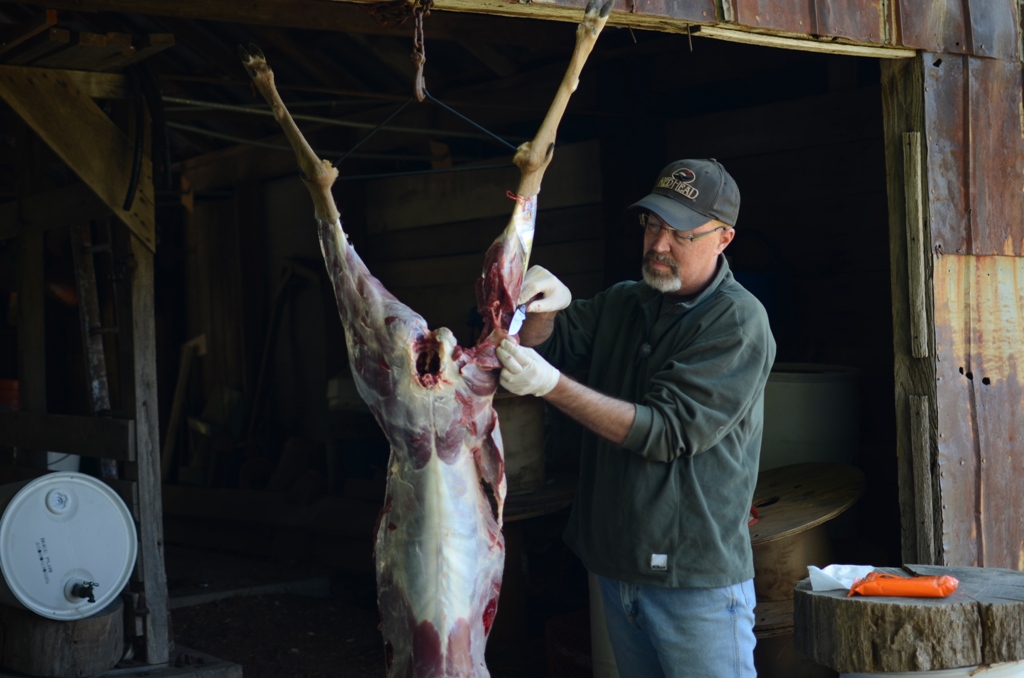
Fill the freezer during the early season!
Harvesting does during the early portion of season accomplishes many objectives. First and foremost, more food is saved for deer during the potentially harsh winter months. Deer that are taken during the later part of season have been foraging on food plots for months. If these deer are harvested as season opens then more food will be available for deer that make it through season. Severity of winters is always unknown, so conserving forage by tagging antlerless deer early is often a sound practice. It’s important to remember the stress associated with carrying fawns and rutting behavior. Having adequate nutrition is a must to get deer through the winter months in the best condition possible.
Another reason to reduce deer numbers earlier rather than later is the possibility of experiencing a more intense rut. When the adult sex ratio is balanced, bucks must work harder to find another receptive doe. This means more time on their feet. When a deer is more active it is typically easier to harvest. By tagging does earlier rather than later, it’s possible to experience the rut activity you’ve dreamed about.
In addition, harvesting does early can take the pressure off the season. Hunters get additional experience and confidence in their abilities. This added confidence in marksmanship and woodsmanship will be put to the test during the long sits in November.
There are many benefits to tagging does as season opens. If the land you hunt is in need of doe management consider doing so in the first few weeks of season.
Enjoying Creation,
Matt Dye
How to Respond to Consistent Deer Movement
Just two weeks back we discussed how to keep tabs on deer movement throughout a season. We’ve already placed our Reconyx cameras overlooking fields. When we reviewed the most recent data there was a clear pattern on many of the food plots. Most evenings multiple deer were entering the plots and feeding until dark. On many occasions deer were entering these plots from multiple locations. A single camera overlooking a trail would not tell the complete story. This means possibly leaving you guessing on where to hunt!
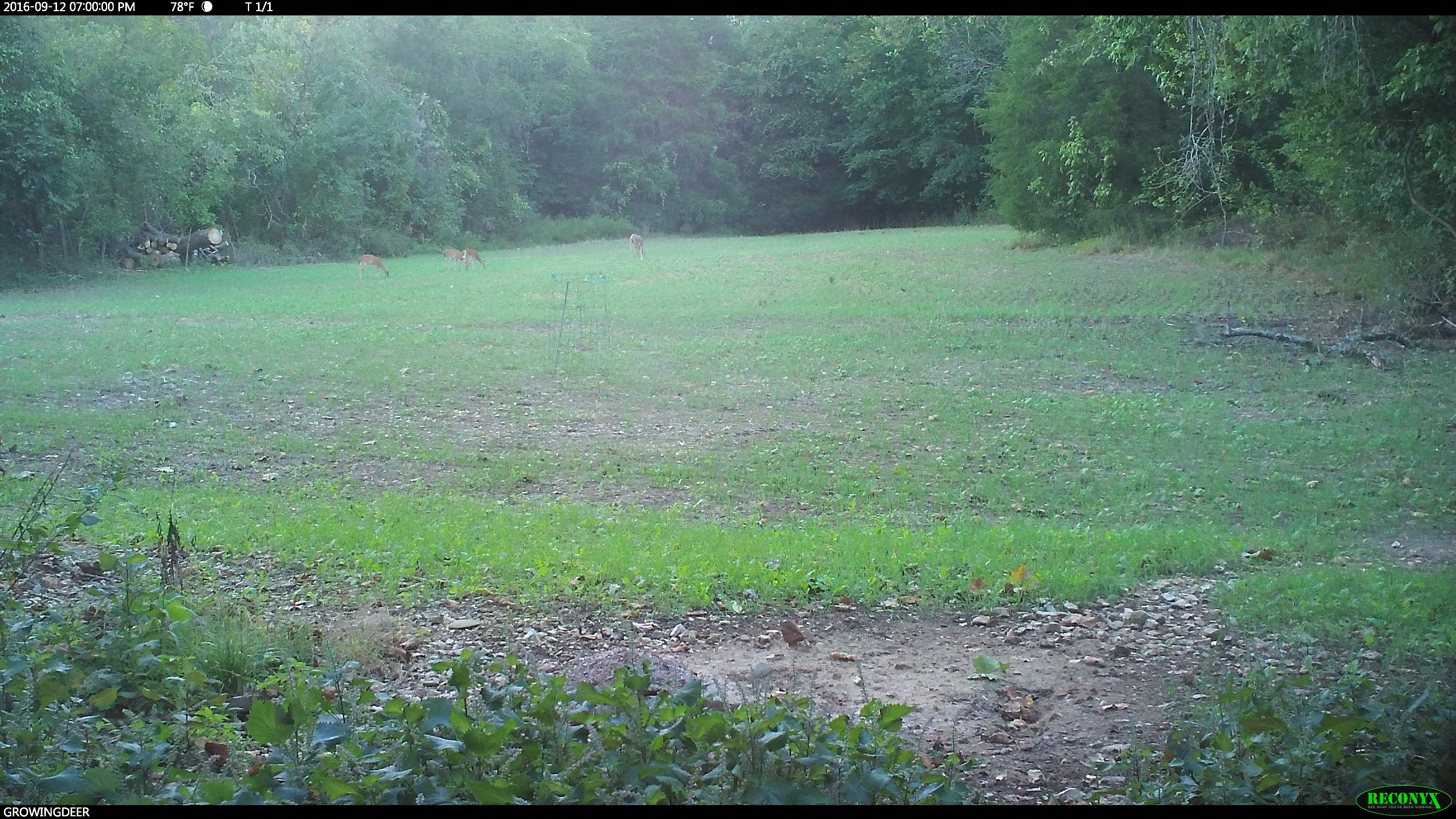
Time to move in the Redneck Hay Bale Blind; these deer have been showing up every evening!
Now we have a great pattern identified. It’s time to take the next step and capitalize on these movements. Resources or weather can change rapidly so we must react quickly to set the stage for a hunt.
One way we are able to move in quickly is by using Redneck Hay Bale Blinds. These blinds closely resemble a hay bale, therefore deer don’t typically associate them with danger. We often don’t have to wait for the deer to grow accustomed to the blinds. The blind can be placed and hunted immediately if the wind is right. In some cases, hanging new tree stands may require excessive trimming which draws attention to that area. The hay bale blind offers a subtle approach with limited disturbance.
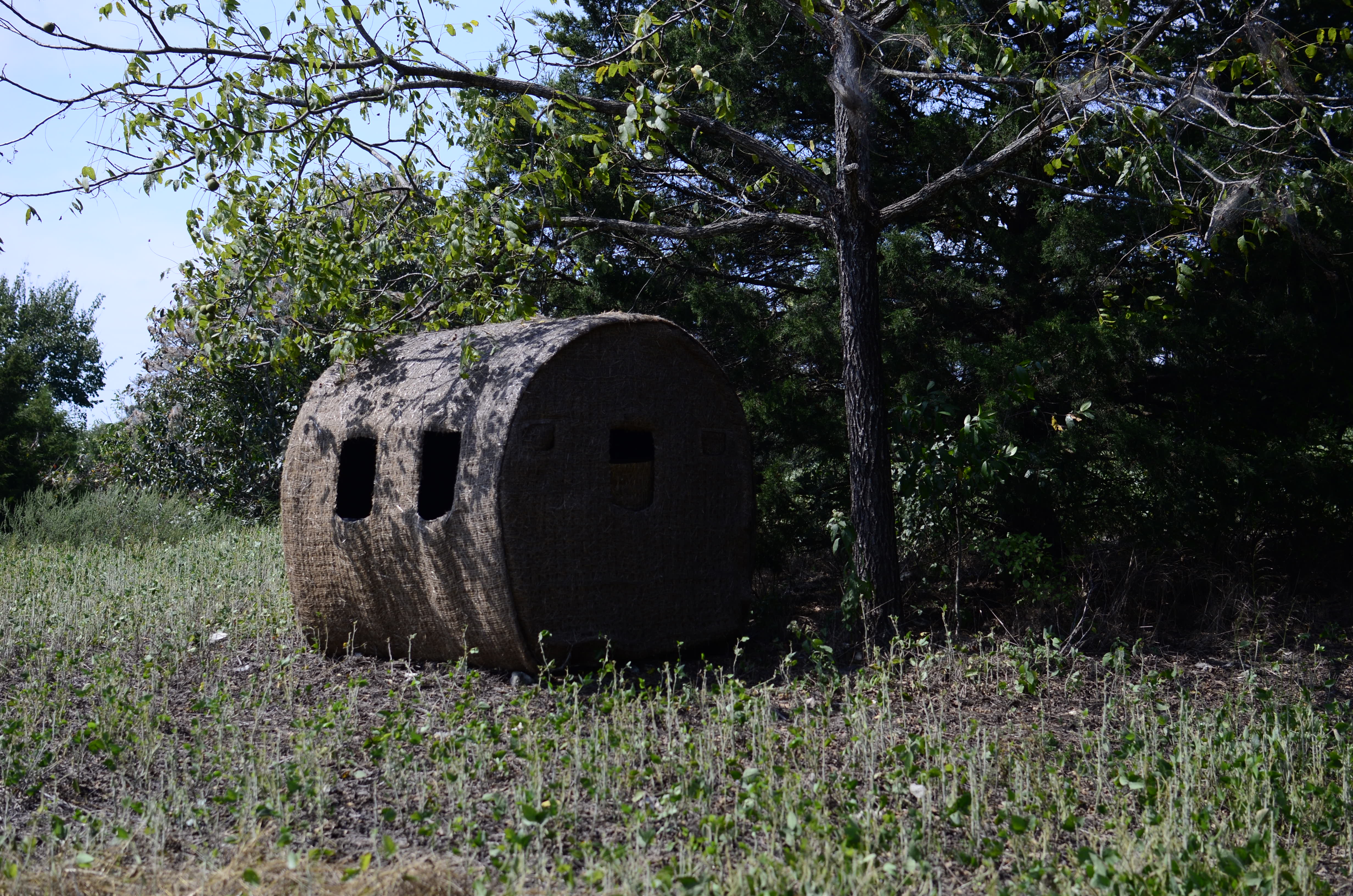
Proper placement of the blind will increase your odds of success.
The final step is placing the blind in the proper location within the plot. This requires forethought on which wind is needed to approach, hunt, and exit undetected. Some of our blinds allow us to leave the blind even when deer are present because of terrain features. Other blinds may require the hunters to be dropped off and picked up. Instead of the hunters spooking deer as they leave, a vehicle clears the field so hunters may leave cleanly.
Successful hunts don’t often come without work and a well designed plan. Efficiently monitoring deer movements, reacting quickly, and hunting smart are steps we follow each season. This multistep process can be repeated anywhere!
Safe and successful hunting,
Matt
How To Gain MRI
I’ve got to keep it brief today! The sound of sprinkles are chiming off the tin roof. The Proving Grounds hasn’t experienced rain in weeks. This rain isn’t going to end the drought, but we are hopeful it will refresh our planted food plots as well as give life to seed we plan to broadcast.
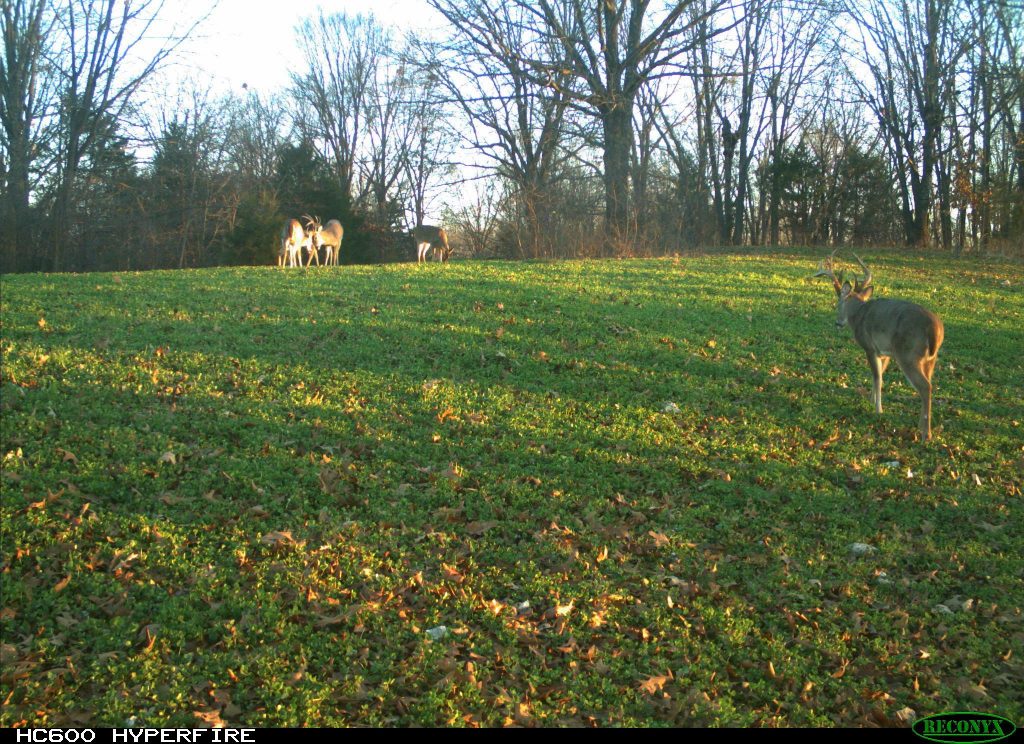
This camera was placed to overlook an entire food plot. It captured MRI of a buck we call Handy.
In final preparations before season opens we are adjusting our trail cameras to provide us with the Most Recent Information (MRI) throughout the entire season. This means placing our Reconyx cameras on scrapes or monitoring food plots using the time lapse feature.
The time lapse feature on trail cameras is an extremely valuable tool to deer hunters. When cameras are placed properly overlooking a field on the time lapse feature they replace the need for humans to scout. The trail camera gathers more information about when deer are coming and going, feeding, as well as entering and exiting the field in a week’s time than a personal scouting trip into the field. Not to mention they are scent free.
We place trail cameras high in trees and set them to take photos on five, ten, or fifteen minute intervals for the first few hours of daylight and then again during the last few hours of daylight. This provides us the information we need to hunt successfully. Our hunting strategy discourages hunting directly over food plots, but these trail cameras show us which trails deer are using as they enter the plot. With this data we can select the stand that will intercept those deer as they make their way to the food plot. Hunting deer in transition allows the food plot to remain a safe feeding destination, ensuring deer keep returning.
We’ve used this strategy for years and much of our success is based around gaining MRI and adapting quickly to changes just as deer commonly do. Prior to season, set your trail cameras to cover large food plots using the time lapse feature. Scout scent free all the way through the season, gaining valuable MRI day by day.
Rain is coming in, so the seed must get sown!
Enjoying Creation together,
Matt
Hunting When The Temperature Rises
Many states will be opening up bow seasons in the next few weeks. This is an exciting time for deer hunters to capitalize on late summer deer patterns. The days are long during this portion of season, therefore daylight activity is more common. A typical early season stand may be positioned near a food source where hunters have seen their prize feeding for months. This is typically a great location to be hunting when conditions allow.
As deer begin to shed summer coats and put on their winter coats, changes in activity can be seen. The food source may not change, but the activity level of deer do. Early season is known for its warm temperatures. As hunters we experience this as we attempt to not sweat, while deer may alter their movement patterns. Their heavier winter coats tend to make deer move more during the last few moments of light when the temperatures are cooler.
Just as the deer are adapting, we as hunters must as well. Hunting closer to the edges of bedding cover may result in more punched tags. Cutting the distance between feeding to bedding is a great option when the thermometer rises. Although this may sound simple, a few extra steps should be taken to ensure your success.
The approach and exit to this setup should not interfere with any deer. In some cases it may be the best practice to cut in a trail to the stand before season begins. Blowing out the trail of any sticks or leaves will result in a silent approach and exit. Being cautious of your scent is just as important. Just as you play the wind during a hunt, make sure the wind allows you to move safely without alerting deer.
Understanding and anticipating how deer will react to changes in conditions will make you a better and more successful hunter.
Happy Hunting,
Matt





















